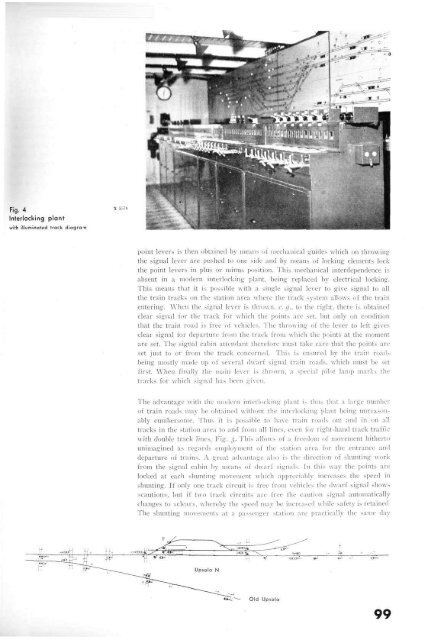ericsson review - History of Ericsson - History of Ericsson
ericsson review - History of Ericsson - History of Ericsson
ericsson review - History of Ericsson - History of Ericsson
Create successful ePaper yourself
Turn your PDF publications into a flip-book with our unique Google optimized e-Paper software.
Fig. 4<br />
Interlocking plant<br />
with illuminated track diagram<br />
point levers is then obtained by means <strong>of</strong> mechanical guides which on throwing<br />
the signal lever are pushed to one side and by means <strong>of</strong> locking elements lock<br />
the point levers in plus or minus position. This mechanical interdependence is<br />
absent in a modern interlocking plant, being replaced by electrical locking.<br />
This means that it is possible with a single signal lever to give signal to all<br />
the train tracks on the station area where the track system allows <strong>of</strong> the train<br />
entering. When the signal lever is thrown, e. g.. to the right, there is obtained<br />
clear signal for the track for which the points are set, but only on condition<br />
that the train road is free <strong>of</strong> vehicles. The throwing <strong>of</strong> the lever to left gives<br />
clear signal for departure from the track from which the points at the moment<br />
are set. The signal cabin attendant therefore must take care that the points are<br />
set just to or from the track concerned. This is ensured by the train roads<br />
being mostly made up <strong>of</strong> several dwarf signal train roads, which must be set<br />
first. When finally the main lever is thrown, a special pilot lamp marks the<br />
tracks for which signal has been given.<br />
The advantage with the modern interlocking plant ^ thus that a large number<br />
<strong>of</strong> train roads may be obtained without the interlocking plant being unreasonably<br />
cumbersome. Thus it is possible to have train roads out and in on all<br />
tracks in the station area to and from all lines, even for right-hand track traffic<br />
with double track lines, Fig. 3.. This allows <strong>of</strong> a freedom <strong>of</strong> movement hitherto<br />
unimagined as regards employment <strong>of</strong> the station area for the entrance and<br />
departure <strong>of</strong> trains. A great advantage also is the direction <strong>of</strong> shunting work<br />
from the signal cabin by means <strong>of</strong> dwarf signals. In this way the points are<br />
locked at each shunting movement which appreciably increases the speed in<br />
shunting. If only one track circuit is free from vehicles the dwarf signal shows<br />
»caution», but if two track circuits are free the caution signal automatically<br />
changes to »clear», whereby the speed may be increased while safety is retained.<br />
The shunting movements at a passenger station are practically the same day<br />
99
















